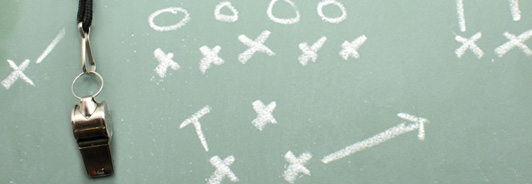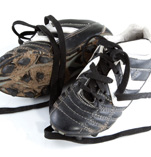Coaching Evolution: A historical look at instruction at UNC
1912 — As part of a bachelor’s degree program in teaching, summer courses covering outdoor games, gymnastics and folk dances are offered to prepare teachers for supervising physical education and directing playground activities.
1925 — Nearly 100 students enroll in the inaugural School for Coaches, billed as the first of its kind in the Rocky Mountain West. The program advertised the income at $1,500–$2,400 a year for a classroom teacher who could coach.
1961 — Two-credit-hour courses in coaching offered for: football, basketball, track and field, baseball, swimming, wrestling and gymnastics. Basketball, volleyball, softball and touch football were offered in more than half of the 153 high schools in Colorado.
1962 — A coaching emphasis is offered as part of a minor in P.E. teaching. Head coaches of Bears’ programs, including George Sage, Pete Butler and John W. Hancock, instruct courses. A coaching minor is still offered today.
1972 — Title IX passes, creating a need for more qualified coaches.
1980s — UNC faculty, including Carolyn Cody, travel the country to educate athletic directors on how to train coaches who don’t hold P.E. degrees.
1990s — Correspondence courses on coaching offered with online components coming into the fold with the advent of the Internet.
2003 — Coaching, physical education, athletic training and sport administration become part of new School of Sport and Exercise Science.
2011 — Online master’s degree program in sports coaching begins.
Sources: UNC Archival material, interviews with Carolyn Cody and George Sage
History of Coaching Curriculum at UNC
George Sage (BA-55, MA-57) not only led Bears basketball teams to the NCAA tournament three times over seven years as head coach, the professor emeritus also presided in the classroom, drawing on some of the lessons he learned from his mentor and friend — legendary UCLA coach John Wooden.
Sage says the same arrangement held true for other head coaches of the era, including Pete Butler (baseball) and John W. Hancock (wrestling) — the names that adorn UNC’s Division I sports pavilion.
Student-athletes at the time, such as Don Meyer (BA-67, MA-68) and Ron Vlasin (BA-66) — teammates and pupils of Sage — went on to record-setting coaching careers themselves.
“The thought at the time was that there are people coming here who didn’t want to major in P.E., but who wanted to be teachers, and they wanted to coach,” Sage says on the reason the coaching minor was introduced during his tenure.
For as long as anyone can remember, UNC has offered resources to prepare coaches for the rigors of the job.
Carolyn Cody (MA-67), professor emerita of Physical Education and, like Sage, a member of UNC’s Athletic Hall of Fame, traveled the country as part of a national “train-the-trainers” coaching program in the 1980s.
Cody says the model addressed a demand for more credentialed coaches stemming in part from the adoption of Title IX.
UNC began offering correspondence courses in the 1990s that evolved with the advent of the Internet, recalls Cody, who retired in 1998 as assistant vice president for Academic Affairs.
“You can’t be a good coach without being a good teacher,” says Cody, who also served as Bears gymnastics coach from 1967 to 1981 and whose 1974 team finished 13th in the nation. “Good teaching is fundamental.”
List of some UNC graduates who went on to successful coaching careers:
- Tom Runnells — Bench coach for the Colorado Rockies who managed the Montreal Expos.
- Mike Anderson — Head baseball coach at the University of Nebraska from 2003-11. He went to the College World Series in 2005.
- Don Meyer — His 923-324 record in 38 years at Hamline (1973-75), Lipscomb (1976-99) and Northern State (2000-2010) is second only to Duke’s Mike Krzyzewski.
- Duane Banks — Head baseball coach at Iowa from 1970 through 1997 and all-time winningest coach at Iowa. Iowa’s field is named after him.
- Ruth Nelson — A five-sport athlete at UNC who went on to coach volleyball at George Williams, Houston, LSU and Iowa and was an assistant coach on the Olympic Team.
- Jerry Krause — Director of Operations for Gonzaga men’s basketball team. Considered the most widely published coach in basketball history with more than 30 books.
- Greg Riddoch — Manager of the San Diego Padres from 1990-92.
- Ron Vlasin — UNC women’s basketball coach from 2001-06, won nine state high school basketball championships, more than any other coach in Colorado history.






